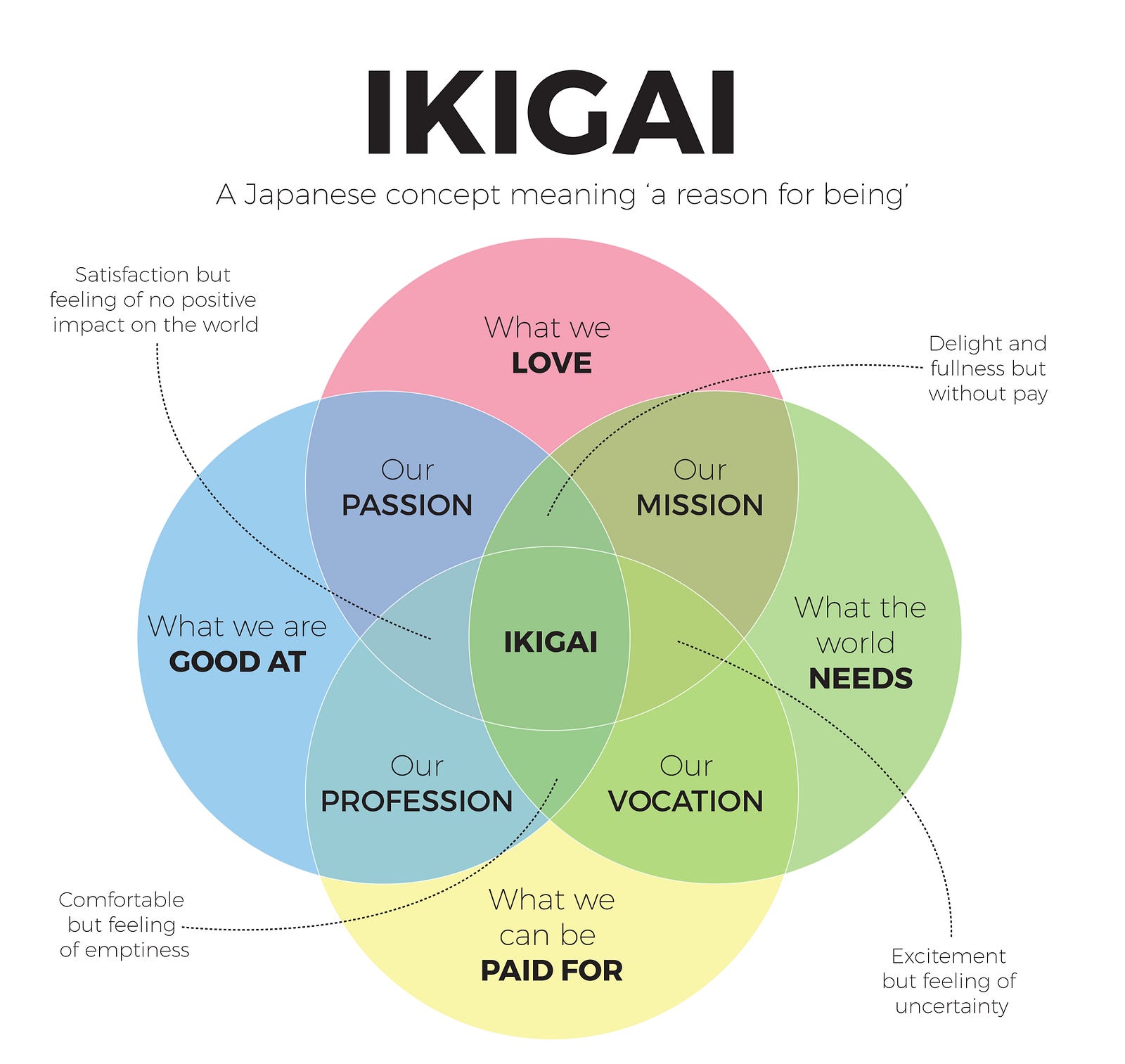Afternote:
Since researching Ikigai, it has become a prominent part of my practice, which already is heavily focused on pooling Eastern and Western values and teachings.
Ikigai: The Japanese Secret to a Long and Happy Life

In Japan, millions of people have ikigai (pronounced Ick-ee-guy)— a reason to jump out of bed each morning. Could the concept of ikigai contribute to longevity?
Make three lists:
1. your values
2. things you like to do
3. things you are good at
The cross section of the three lists is your ikigai.
Studies show that losing one’s purpose can have a detrimental effect.
'Your ikigai is at the intersection of what you are good at and what you love doing,” says Hector Garcia, the co-author of Ikigai: The Japanese Secret to a Long and Happy Life. He writes,“Just as humans have lusted after objects and money since the dawn of time, other humans have felt dissatisfaction at the relentless pursuit of money and fame and have instead focused on something bigger than their own material wealth. This has over the years been described using many different words and practices, but always hearkening back to the central core of meaningfulness in life.'
Ikigai is seen as the convergence of four primary elements:
- What you love (your passion)
- What the world needs (your mission)
- What you are good at (your vocation)
- What you can get paid for (your profession)
Ask yourself the following four questions:
1. What do I love?
2. What am I good at?
3. What can I be paid for now — or something that could transform into my future hustle?
4. What does the world need?
In their book Ikigai The Japanese Secret to a Long and Happy Life, Hector Garcia and Francesc Miralles break down the ten rules that can help anyone find their own ikigai.
1. Stay active and don’t retire
2. Leave urgency behind and adopt a slower pace of life
3. Only eat until you are 80 per cent full
4. Surround yourself with good friends
5. Get in shape through daily, gentle exercise
6. Smile and acknowledge people around you
7. Reconnect with nature
8. Give thanks to anything that brightens our day and makes us feel alive.
9. Live in the moment
10. Follow your ikigai
Further context
- What you deeply care about can unlock your ikigai
- Follow your curiosity.
- Philosopher and civil rights leader Howard W Thurman said, “Ask what makes you come alive and go do it.” … “Don’t ask what the world needs. Ask what makes you come alive, and go do it. Because what the world needs is people who have come alive.”
- The problem for millions of people is that they stop being curious about new experiences as they assume responsibilities and build routines. Their sense of wonder starts to escape them.
- Albert Einstein encourages us to pursue our curiosities. He once said:
“Don’t think about why you question, simply don’t stop questioning. Don’t worry about what you can’t answer, and don’t try to explain what you can’t know. Curiosity is its own reason. Aren’t you in awe when you contemplate the mysteries of eternity, of life, of the marvelous structure behind reality? And this is the miracle of the human mind — to use its constructions, concepts, and formulas as tools to explain what man sees, feels and touches. Try to comprehend a little more each day. Have holy curiosity.”
- A classic example is Steve Jobs’ curiosity for typefaces which led him to attend a seemingly useless class on typography and to develop his design sensibility. Later, this sensibility became an essential part of Apple computers and Apple’s core differentiator in the market.
- We are born curious. Our insatiable drive to learn, invent, explore, and study deserves to have the same status as every other drive in our lives.
- Fulfilment is fast becoming the main priority for most of us. Millions of people still struggle to find what they are meant to do. What excites them. What makes them lose the sense of time. What brings out the best in them.
Use in practice
Based on this knowledge, the concept of ikigai was referenced in a a Children's book I wrote and designed with an Illustrator. The story follows a child called Phoenix who is so scared of the dark that they travel the world in a balloon ship to flea the night. Ikigai is brought up when the protagonist visits Japan.


No comments:
Post a Comment